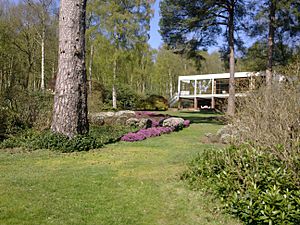The Homewood facts for kids
Quick facts for kids The Homewood |
|
|---|---|

The Homewood and Garden
|
|
| Type | Private house |
| Location | Esher |
| Area | Surrey |
| Built | 1938 |
| Architect | Patrick Gwynne |
| Architectural style(s) | Modernist |
| Owner | National Trust |
|
Listed Building – Grade II
|
|
| Official name: The Homewood | |
| Designated | 28 January 1971 |
| Reference no. | 1365884 |
| Lua error in Module:Location_map at line 420: attempt to index field 'wikibase' (a nil value). | |
The Homewood is a cool, modern house located in Esher, Surrey, England. It was designed by a talented architect named Patrick Gwynne especially for his parents. Later, in 1999, Gwynne gave this unique house to the National Trust, a charity that protects historic places.
Contents
Building The Homewood
The Homewood stands where an older, larger Victorian house once was. Patrick Gwynne's family decided to knock down the old house to build this new, modern one. Patrick was only 24 years old when he designed it! The family sold some property to help pay for the project.
Patrick Gwynne's Design Ideas
The Homewood was Patrick Gwynne's very first house design, and it remained his favorite. He was inspired by famous architects like Le Corbusier and Ludwig Mies van der Rohe. These architects were pioneers of the "International Style," a type of modern architecture popular in the 1920s.
Designing Everything Inside and Out
Just like some other famous architects, Patrick Gwynne designed almost everything for The Homewood. This included the furniture, the special fittings, and even the way the gardens were laid out. He wanted the house and its surroundings to work together perfectly.
He used two main measurements to make sure everything was in proportion. A vertical measurement of 20 inches helped decide heights for things like windows and ceilings. A horizontal measurement of four feet was used for widths.
How The House Is Organized
The new Homewood was planned very carefully. Bedrooms and offices were placed on one side of the house. On the other side, you would find the living areas and utility rooms. There was even a separate area for staff at one end.
One of the most interesting features is that the house is built on stilts, called pilotis. This created space underneath for cars and the main entrance.
The Homewood's Modern Style
The Homewood looks very sleek and modern, with clean lines and industrial materials like concrete. It has an open-plan design, meaning rooms flow into each other without many walls. Furniture helps define different areas.
Cool Features and Details
The house is designed to be simple, spacious, and useful, but also very comfortable. For example, the concrete staircase inside is lit by a hidden light in the floor. The house has special wallpapers and clever inventions. These include blinds that can be controlled automatically over the huge floor-to-ceiling windows.
There are also work desks that can change their use, and cabinets with hidden storage and even lights inside. Each bedroom originally had its own bathroom. The main colors used are neutral, like cream, white, brown, and black, with a few touches of sky blue. However, there is one fancy glass chandelier that stands out on the landing.
Patrick Gwynne used The Homewood as a showcase for his work. It showed clients and students his amazing skills in architecture, furniture design, and attention to every detail.
Life at The Homewood After the War
After World War II, it became harder to have staff. So, Gwynne made some changes. He added a swimming pool and turned the old staff quarters into a fun area for entertainment and relaxing. This meant parties could happen on the ground floor instead of on the roof, which was a popular trend in the 1930s.
Since each family member had a car, the stilts provided space for four cars to park underneath, completely covered. Patrick Gwynne's own blue-green Aston Martin car is still kept at The Homewood today.
The Homewood During Wartime
When Patrick, his sister, and his father joined the war effort, the house was rented out. Sadly, both of Patrick's parents passed away before the war ended. After his sister moved out to get married, Patrick lived alone in the house for 46 years. In his later years, he lived in the former staff quarters while working with the National Trust to bring the house back to its original look.
The Homewood Today
Patrick Gwynne started talking with the National Trust in 1993 about giving them the house. He officially gave it to them in 1999. He had a special agreement: he could live there until he passed away. After that, a family would live in the house, and it would be open to the public one day a week for six months of the year. The National Trust also agreed to fix up and improve parts of the house under his guidance.
Patrick Gwynne passed away in May 2003. In October 2007, a family – David Scott, Louise Cavanagh, and their daughter Isabella – moved into The Homewood. The house has even been featured in TV shows like Endeavour and Agatha Christie's Marple (in the episode based on Endless Night). You can visit The Homewood on certain Fridays and Saturdays from April to October.
Photo gallery













